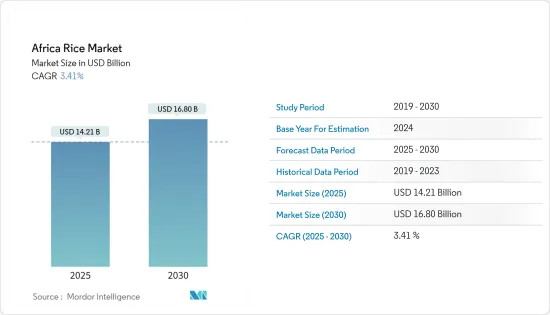PUBLISHER: Mordor Intelligence | PRODUCT CODE: 1687070

PUBLISHER: Mordor Intelligence | PRODUCT CODE: 1687070
Africa Rice - Market Share Analysis, Industry Trends & Statistics, Growth Forecasts (2025 - 2030)
The Africa Rice Market size is estimated at USD 14.21 billion in 2025, and is expected to reach USD 16.80 billion by 2030, at a CAGR of 3.41% during the forecast period (2025-2030).

Key Highlights
- Rice has emerged as a crucial staple in Africa, with demand surging from about 10 million metric tons in 1990 to over 40 million metric tons in 2023. This increase is largely attributed to rapid population growth and evolving dietary habits, notably a rise in caloric intake from rice, from 7% to 9%. Despite yield improvements, Africa's rice production lags behind demand, resulting in increased dependence on imports. According to ITC Trade Map, over 20% of the continent's rice demand is met through imports, primarily sourced from Southeast Asia and India. This dependence on external sources renders Africa vulnerable to supply disruptions and price fluctuations.
- In Africa, rice cultivation is predominantly undertaken by smallholder farmers. In contrast, large-scale firms and trading companies contribute about 10% to the total production. The region's primary rice producers are Nigeria, Cote D'lvoire, Madagascar, Mali, and Tanzania. While these nations benefit from favorable climatic conditions for rice cultivation, rising domestic consumption is predominantly met through imports. A significant shift in consumer preferences, especially in West Africa, has intensified the regional supply and demand imbalance, propelling the rice market's growth.
Africa Rice Market Trends
Expanding Production Potential in the Region
Most African countries are heavily dependent on imports to satiate the growing demand for rice among consumers. However, with the introduction of focused rice cultivation through several studies, domestic production increased during the study period. With consistently low levels of productivity across the region, the Global Agroecological Zones (GAEZ) analytical work was developed by the International Institute for Applied Systems Analysis (IIASA) to prepare maps of land suitability for rice production in the African region. This enabled the identification of appropriate land for rice cultivation, which has steered rice production.
According to the Food and Agriculture Organization (FAO), rice production in Africa increased from 36.4 million metric tons to 39.8 million metric tons between 2019 and 2022. This increase can be attributed to farmers investing in irrigation and millers engaging in contract farming with smallholder farmers to source paddy. These activities have provided farmers with a stable income and boosted rice production in the region. The adoption of new agricultural practices in Africa is anticipated to further drive domestic rice supply and market growth in the region.
Cote d'Ivoire is One of the Key Importers of Rice
The demand for rice as a staple food has increased in Cote d'Ivoire due to rising demand from middle-income class consumers. Smallholder farmers are the country's primary rice producers, and domestic rice consumption has been steadily increasing due to population growth. However, local production only covers 50% of the country's consumption, making Cote d'Ivoire heavily dependent on imports. The rice sector is currently informal, fragmented, and inefficient, resulting in a lack of competitiveness against imported rice.
According to ITC Trade Map data, in 2023, Cote d'Ivoire imported 1.3 million metric tons of rice, making it one of the largest rice importers in the world. It is estimated that by 2025, 2.0 million metric tons of milled rice will be needed to meet domestic consumption. Cote d'Ivoire primarily imports rice from India (594.6 thousand metric tons), Vietnam (489.7 thousand metric tons), Pakistan (100.3 thousand metric tons), Thailand (59.7 thousand metric tons), and China (45.2 thousand metric tons). With population growth and evolving consumer dietary preferences, the demand for rice is anticipated to rise in the years ahead.
Additional Benefits:
- The market estimate (ME) sheet in Excel format
- 3 months of analyst support
TABLE OF CONTENTS
1 INTRODUCTION
- 1.1 Study Assumption and Market Definition
- 1.2 Scope of the Study
2 RESEARCH METHODOLOGY
3 EXECUTIVE SUMMARY
4 MARKET DYNAMICS
- 4.1 Market Overview
- 4.2 Market Drivers
- 4.3 Market Restraints
- 4.4 Value Chain Analysis
5 MARKET SEGMENTATION
- 5.1 By Geography (Production Analysis by Volume, Consumption Analysis by Volume and Value, Import Analysis by Volume and Value, Export Analysis by Volume and Value, and Price Trend Analysis)
- 5.1.1 South Africa
- 5.1.2 Ghana
- 5.1.3 Nigeria
- 5.1.4 Cote D'lvoire
- 5.1.5 Cameroon
- 5.1.6 Madagascar
- 5.1.7 Niger
- 5.1.8 Ivory Coast
- 5.1.9 Senegal
- 5.1.10 Guinea Bissau
- 5.1.11 Tanzania
6 MARKET OPPORTUNITIES AND FUTURE TRENDS




